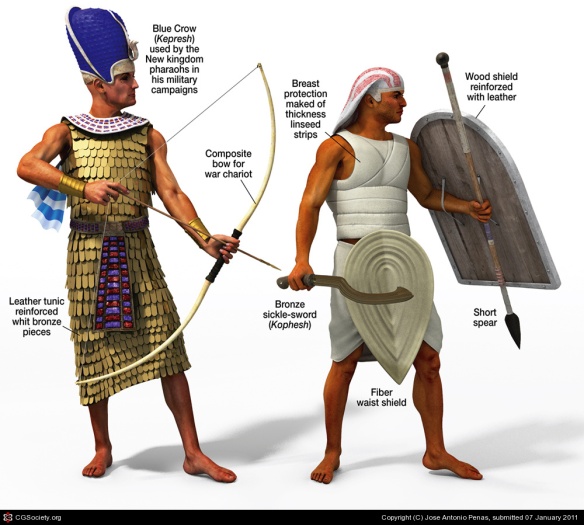Egyptian warriors (New Kingdom) by Jose Antonio Penas
The new unified Egypt established by Ahmose I was a true nation-state, unified in language, culture, and religion and tied to together by the Nile River. The country was blessed by the gods and prospered accordingly. The reintroduction of peace and unity once again made Egypt the richest state in the eastern Mediterranean. However, New Kingdom Egypt was in many ways different from the Egypt of the Old and Middle Periods. The Hyksos invasion and occupation had a dramatic impact on almost every aspect of Egyptian society. The biggest change was the Egyptians’ mortal fear of another inva- sion and occupation. This experience had so scarred the Egyptians that they decided they must do everything possible to prevent and defend against similar attacks in the future.
In previous periods, the Egyptians had only a small militia without professional soldiers or officers. In general, military service and the army were looked down on by Egyptian society. Now, for the first time in history, the Egyptians created a professional standing army. The leader of this new army would be a new type of king: the warrior-pharaoh. Egyptian art, in a sharp break from past practices, now depicted the king as a military leader riding in his chariot, firing arrows, wielding a sword, and holding by the hair enemies who would be either executed or enslaved. Inspired by the pharaoh’s example, the people of Egypt now looked on the army as a source of strength, unity, and national pride, the only instrument that protected the Nile Valley against further attacks. Military service was now a noble profession and a sacred duty for the defense of Egypt.
The Egyptians created an army of 20,000 permanent professional soldiers. These men were divided into four divisions, each named after an Egyptian god: Amon, Ptah, Ra, and Seth. The names of the units demon- strate that warfare was part of a holy crusade to expand and defend the power of Egypt with the full support of the gods. The army was equipped with the latest technology, much of which had been learned from the Hyksos. Bronze body armor, longer swords, and lighter shields all become standard. The Egyptians also created a chariot squadron numbering more than 3,000 vehicles; this was the core of the army’s power. These units could also be augmented by further temporary conscription in time of emergency.
This new army would not be used merely to defend Egypt against attack. A conscious decision was made to alter more than a thousand years of Egyp- tian foreign policy. The Egyptians decided they must create an empire to establish buffer zones between the Nile Valley and its enemies. The more territory the Egyptians conquered the further potential invaders would be from the Nile. Despite incredible power and wealth dating back to its found- ing in 3100 B . C . E ., Egypt had rarely ventured abroad. Now, for the first time, Egypt would attempt to conquer an empire.
